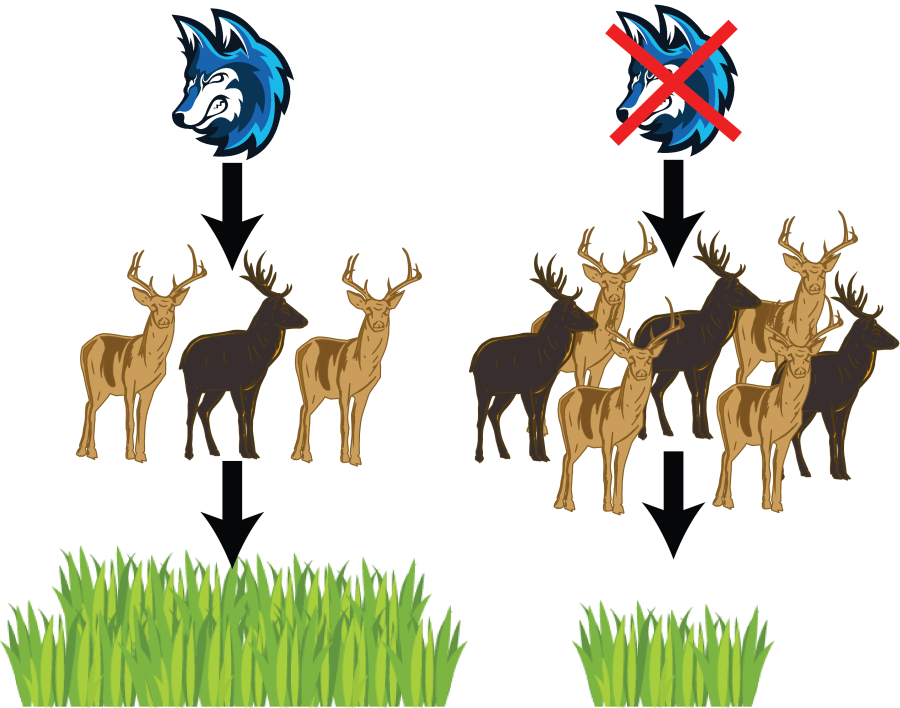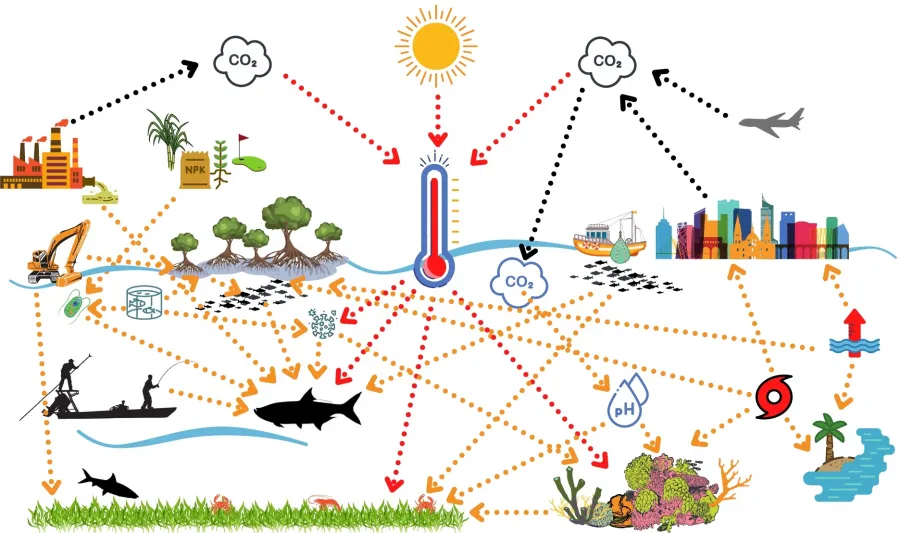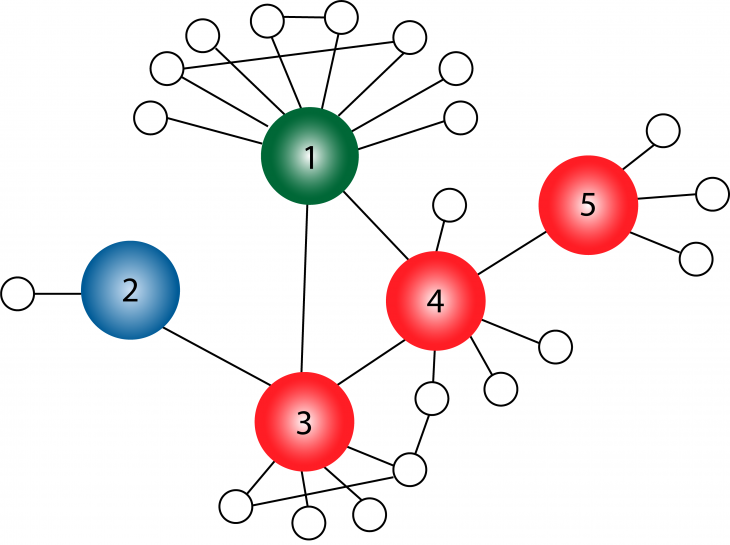
Due to the many interactions and feedbacks that occur in a complex system, changes in one part of a system can have cascading effects that cause sequential changes in the system’s other parts. Cascading effects can occur in many types of complex systems, including ecological, social, and socio-environmental ones. As described in the associated Explainer “Introduction to Cascades: Ecological, Social, and Socio-Environmental,” cascades of change occur in a networked system and are most likely to find momentum through specific enabling conditions that alter the network’s structure. Cascades can result in major changes to the system, i.e., regime shifts. Social cascades differ from ecological cascades in important ways because social systems involve human agency. Ecological cascades usually begin with some perturbation to a system of interacting species such as extirpation or change in abundance of species due, for example, to the loss of a top predator (Altieri et al. 2012, Rodríguez-Lozano 2015) or the spread of disease (Monk et al. 2022). But they can also occur via indirect ecological effects, i.e., if a species depends on interacting with another if the latter is extirpated this can cause a change in the population of the species which can have cascading effects on other species (Doherty et al. 2023). As this lesson demonstrates, ecological cascades can involve entire changes to food webs due to sequential extirpation events when a species dies off and/or an invasive species arrives (Kotta et al. 2018). Social events, such as the development of a new fishing technology that results in the overfishing of a top predator (Steneck and Pauly 2019), can also enable trophic cascades. Examples of cascading effects in socio-environmental systems include economic and social upheaval triggered by climate change (Franzke et al. 2022) and cascading environmental hazards that have more severe social consequences (e.g., droughts that lead to fires) (Brito et al. 2022).
This first lesson, in a three-part series on cascades, focuses on ecological systems and how communities of species can experience cascading effects. After introducing learners to the concept of cascading effects, the lesson explores these effects using activities based on food webs and non-native species cascades. The second lesson focuses on social cascades. Here, learners investigate sectors ripe for cascades and then the learners develop plans to enable cascades that will lead to positive social changes. The third lesson focuses on socio-environmental cascades using climate change impacts that cascade socio-economically and ecologically. Learners investigate the types of changes in governance that may better protect built infrastructure, humans, and economic systems.
- Study how cascades flow sequentially through ecological networks and how this phenomenon can influence entire ecosystems.
- Identify conditions that enable the establishment of invasive species.
- Identify enabling conditions that may catalyze cascades in ecological communities.
- Consider management plans to control invasive species and their cascading effects.

This figure from an open access article by Danylchuk et al. 2022 depicts the effects of climate change on tropical marine fisheries. Have learners identify in the figure the cascading effects among environmental components that then lead to cascading effects among species.
Cascades of Species Interactions (One, 50-minute class)
-
Prior to the Session. As preparation for the session, have learners read: the SESYNC Explainer “Introduction to Cascading Effects” and excerpts from a paper by David et al. 2017.
DocumentExcerpts from David article.pdf (479.95 KB) -
The Hook. (5 min.) Give learners 2 minutes to complete the hook on their own. As you show the image (PowerPoint slide 2), ask several learners to come up to the board and trace on the image the cascades that they identified.
-
Presentation (10 min.) Open the session with the PowerPoint below, which reviews the basics on cascading effects and includes prompting questions for the instructor to engage the learners. The last slide provides directions for the two activities that follow.
Document -
Finding Cascades in the Literature (25 min.) – Divide the learners into teams of two people. Each group should use the peer-reviewed literature in their university’s online library to find examples of two different types of ecological cascades (e.g., a trophic cascade, cascades involving plants and pollinators, invasive species cascades). Include article literature citations with each. Each team should respond to the following questions with short sentences and complete the worksheet provided in step 5; both team members should agree on the responses and answer them together (i.e., they should not divide the work and do it separately).
Note to Instructor: You may wish to recommend several suitable ecological journals for the learners to search including, for example, BioScience, Frontiers in Ecology & the Environment, Ecology, and the Journal of Ecology.Describe the players (species)and the impacts the cascade had on each.
For each example, draw a network diagram indicating the directionality of the cascade.
Indicate what factor(s) did or might have enabled the cascade.
-
Understanding Networks (10 min). One of the benefits of understanding cascading effects is that it opens the door to potentially preventing future cascades that have negative consequences, e.g., extinctions of a large number of species in a food web, which may lead to the collapse of the network or, at least, major regime changes. Using the below network diagram, highlight those nodes, connections, or parts of the network that correspond best to the following questions. Label them clearly and explain your answer to each. Consider drawing what network results when you implement each. You may use the provided worksheet or do your own drawings.
DocumentRemoval of which node(s) would have the biggest impact on the network?
Which connections are most important to sustaining the integrity of the network i.e., would preserve most of the network?
Add arrows to the lines to indicate the directionality of interactions that would lead to minimizing cascading effects if node (species) 1 was lost.
Repeat the same step as c, but now if node 3 was lost?
-
Bottom-Up Forces in Agroecosystems and Their Potential Impact on Arthropod Pest Management
This article is useful as it clearly exemplifies bottom-up effects and how one can use knowledge of them to manage an ecosystem. The article reviews what is known about bottom-up cascades in pest management of crops and shows how natural enemies (species that prey on pests) can control pests.
Han, P., Lavoir, A.V., Rodriguez-Saona, C. et al. (2022). Bottom-Up Forces in Agroecosystems and Their Potential Impact on Arthropod Pest Management. Annual Review of Entomology, 67, 239–59. https://www.annualreviews.org/doi/full/10.1146/annurev-ento-060121-060505
-
Trophic Cascades Across Diverse Plant Ecosystems
Published by Nature journals, this teaching resource introduces trophic cascades in plant ecosystems. It reviews the history of the concept in ecology and describes how consumers may or may not control plant biomass and species composition.
Silliman, B.R., & Angelini, C. (2012). Trophic Cascades Across Diverse Plant Ecosystems. Nature Education Knowledge 3(10), 44. https://www.nature.com/scitable/knowledge/library/trophic-cascades-across-diverse-plant-ecosystems-80060347/
-
Side-swiped: Ecological cascades emanating from earthworm invasion
This article is useful because it uses an example of a species known to most people—the common earthworm, which is actually an invasive species in North America. It also describes a cascading effect that differs from the top-down or bottom-up effects so often described in the literature. The earthworm has negative impacts on forests where it causes changes in detritus processing (occurring mid-point in the trophic pyramid) and alters soils and nutrients, which leads to warmer, drier soils.
Frelich, L.E., Blossey, B., Cameron, E.K. (2019). Side-swiped: Ecological cascades emanating from earthworm invasion. Frontiers in Ecology & the Environment 17(9): 502–510. https://doi.org/10.1002/fee.2099
-
Trophic Cascades
This article discusses how trophic cascades occur across most types of ecosystems and why they may shift ecosystems to different states. Some learners may find that this article to be behind a paywall.
Pace, M. (2013). Trophic Cascades. In Encyclopedia of Biodiversity (2nd edition), (pp. 258-263). Elsevier. https://www.sciencedirect.com/science/article/abs/pii/B9780123847195003968
